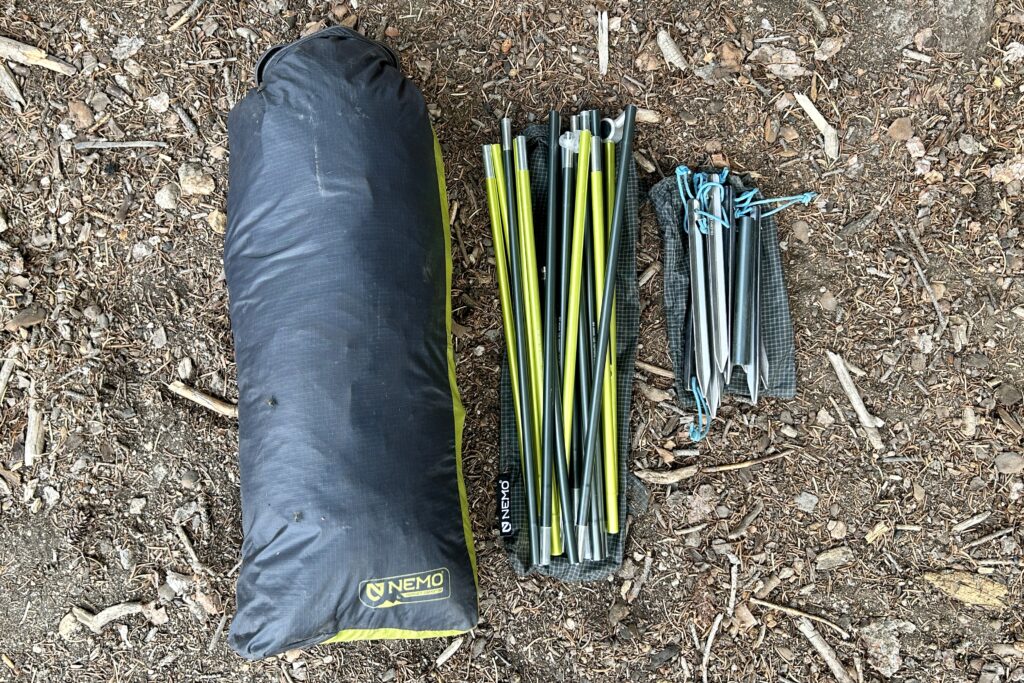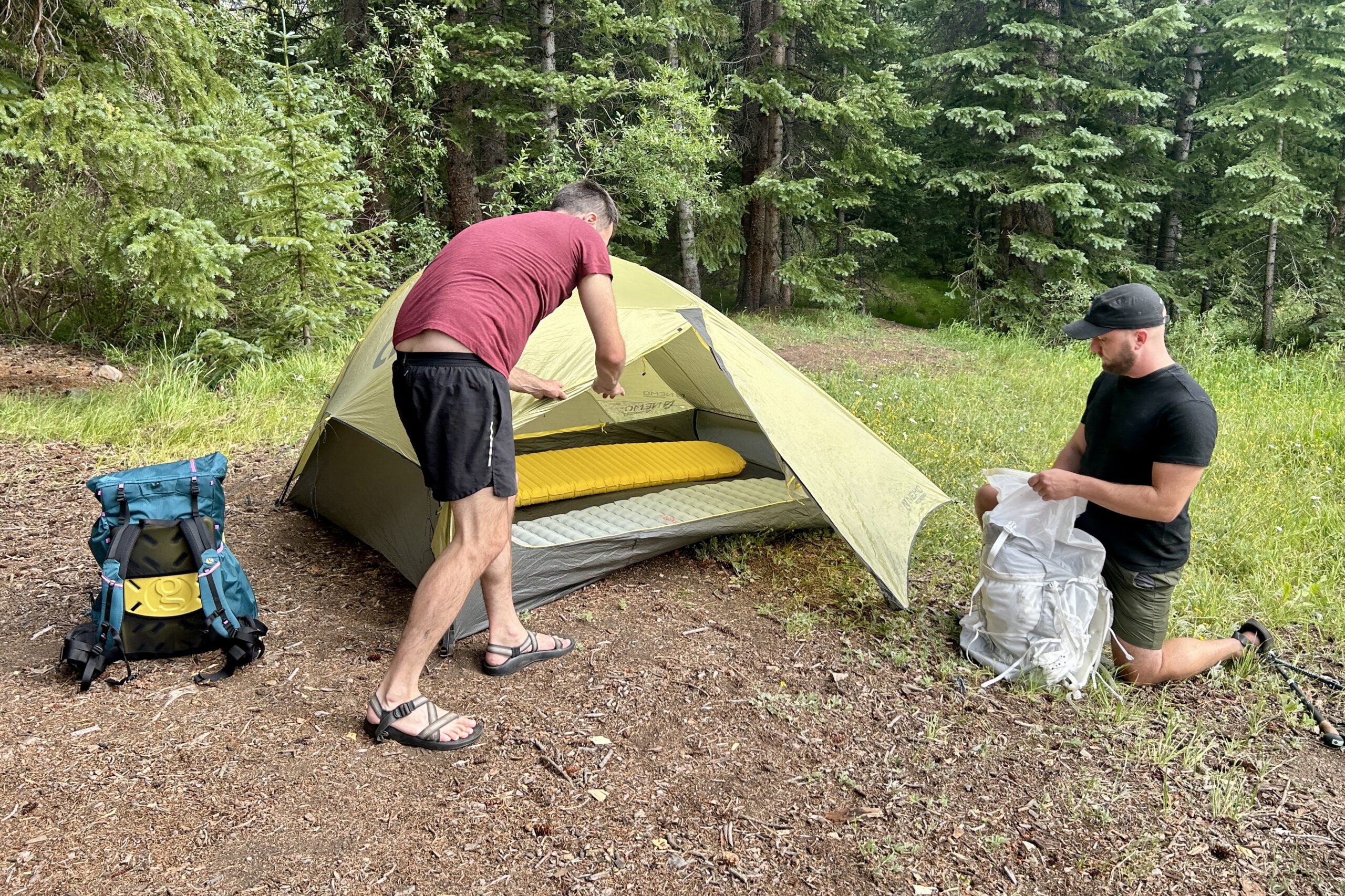Bottom Line
The NEMO Hornet OSMO 3 is a standout ultralight backpacking tent that’s built for comfort and full of clever features. CleverHiker Founder Dave Collins used this tent on backpacking trips in the Wallowa Mountains and the Cascades, and the Hornet 3 is a go-to for Gear Analyst Ian Krammer when backpacking in the Colorado Rockies in summer. The Hornet 3 is a castle in the backcountry with a huge interior, two doors, and large vestibules that easily accommodate two wide sleeping pads and all your gear. The proprietary OSMO fabric repels water with ease, but maintains a taut pitch in soaking wet conditions to keep you dry and cozy inside the tent. And, it’s relatively light weight is a dream for hikers who prioritize weight savings without giving up livability. NEMO’s attention to detail is evident in the tent’s high-quality construction and plentiful interior pockets.
However, the tent does have limitations. The semi-freestanding design means that it requires careful staking for maximum stability, especially when the wind picks up. It’s also too snug for three people to sleep comfortably, making it best for two with extra gear or a dog instead of a trio. And, the price is on the higher side, which might deter budget-conscious backpackers.
Quick Specs

NEMO Hornet OSMO 3
Great Option for UL Hikers Wanting More Space
Price:
$550
Weight:
3 lb. 5 oz.
Dimensions (LxWxH):
88 x 68/62 x 44 in.
Type:
Semi-freestanding
Pros
- Ultralight for the size
- Well-priced for the specs
- Roomy for two
- Convenient pockets
- High-quality materials/construction
- Good ventilation
- Innovative stuff sack makes it easy to split the load
Cons
- Expensive
- Rainfly zippers can snag
- Only one side of the rainfly can be tied back

Comfort
Ultralight doesn’t have to mean sacrificing comfort. With the NEMO Hornet OSMO 3, a pair of hikers can have the conveniences of a traditional 2-person tent – two doors and vestibules, a roomy interior, and useful pockets – without the additional weight. It’s got a ton of room inside – we regularly fit two people, a dog, and all of our gear without feeling cramped – thanks to steep sidewalls and plenty of headroom. The generous floor dimensions and peak height easily fit two wide sleeping pads, so you’ll have plenty of room to toss and turn and spread out.
Dialed-in features like NEMO’s Nightlight Pockets disperse your headlamp light in a soft, even glow thanks to a large overhead pocket to create a super cozy atmosphere inside the tent. Plus, the tent has a huge gear loft pocket that makes it easy to hide clutter, and well-placed side pockets give you dedicated spots for smaller items, from chargers to pocket knives. As an added bonus, this spacious shelter costs around the same amount of money as many of the leading 2-person backpacking tents.
The Hornet OSMO 3 does have some drawbacks, though. Tall users over 6’3” might find the slanted side walls, peak height – just under three and a half feet – and tapered floor restrictive and less comfortable.

Weight & Packability
At only 3 pounds, 5 ounces, the Hornet 3 is super lightweight for a 3-person tent. This is a great choice for backpackers who want to balance weight and space. The semi-freestanding style reduces the number of pole sections, which contributes to its lighter weight, and its double-wall Nylon Ripstop construction makes it extremely packable. The reasonable packed size can be compressed even further using NEMO’s innovative Divvy stuff sack. This stuff sack allows you to efficiently divide the tent’s components inside the bag with a separate section for poles and stakes, fly and tent. This is a small but awesome design feature that’s helpful for splitting the weight of the tent between two to three folks or staying organized while solo. The easy-to-stow design enhances overall packability and usability in the backcountry.
However, while the Hornet 3 is light, it’s not the lightest option available compared to other semi-freestanding models we’ve tested. If your top priority is ultralight and shaving ounces, you may want to keep going. Similarly, the packed size is compact, but still bulkier than non-freestanding minimalist tents. And while we love the Divvy sack for packability, it does add a bit of weight and bulk compared to traditional stuff sacks.

Weather Resistance
The Hornet 3 stands out thanks to its OSMO fabric, which dramatically improves water resistance over standard nylon and polyester rain flies – something we noticed while testing. This quality nylon blend still stretches when wet or cold, although much less than similar tents, so the rainfly stays more taut and doesn’t sag as dramatically. And we love the unique fastener system that uses cord locks and hooks to secure the fly to the tent and keep the rainfly held back on nice days. When you’re caught in a downpour, the Hornet 3’s design ensures you sty dry and sheltered.
Despite its strengths, the Hornet 3 does face some weather-related challenges. This tent can get uncomfortable on hot days and accumulate condensation on cold nights due to a lack of ventilation. Since it only has two small struts positioned at the top of each door, airflow struggles when the rainfly is on. We’ve found the only way to catch a breeze is to open the tent doors, which isn’t ideal in wet conditions or when you need privacy. And, the cord-lock toggles for the rainfly doors are practical, but their low placement is a bit frustrating, since you’re forced to duck down to see past the flap. These are fairly small issues overall, but they impact comfort and protection when storms roll in.

Ease of Setup
With its innovative and intuitive design, pitching the Hornet 3 is easy. The combination of color-coded poles and a simple hubbed structure allows one person to pitch this tent in three minutes or less. NEMO’s Gatekeeper system – a round ball at the end of each pole that snaps into a plastic holder – keeps the poles in place so you can set up solo without worrying about them slipping out. The single Y-shaped pole, also color-coded, aligns with the tent in an intuitive way for fast, simple pitching in wet weather and in low light. Lightweight, high-quality stakes paired with hooks, as well as pre-attached guy lines and built-in guy line tensioners will help you achieve a stable, fast pitch without thinking too hard about it, so you can relax, eat, and get to sleep.
Despite its strengths, the Hornet 3’s semi-freestanding design can be a bit of a headache on uneven or rocky ground. This is an issue with semi-freestanding tents in general: the foot area does bets on packed and flat dirt to achieve the most stability. And, you will likely need to re-tension, or even re-stake your tent in wet and windy conditions, since the fabric tends to stretch when exposed to moisture, making it a bit less convenient in extreme weather. That said, we’ve only run into these issues a few times, and the tent is fast, simple, and intuitive to pitch in most conditions.

Durability
The Hornet 3 proves that durability can go hand in hand with lightweight design. It’s a tough yet nimble and spacious shelter for the backcountry. NEMO uses a 15D nylon body and a fly made from OSMO Ripstop fabric, a technical nylon fabric that gives the tent excellent resilience. According to NEMO, OSMO fabric offers 4x better water repellency and 3x less stretch when wet compared to standard nylon fabrics. Our rigorous backcountry testing backs this up: the Hornet 3 maintained a fairly taut pitch with only one adjustment during a 24-hour downpour, while other comparable tents were noticeably sagging and needed many more tweaks to keep the pitch tight. The Hornet 3 can handle multiple seasons of regular use, making it a great choice for backcountry adventures.
While the Hornet 3’s materials are durable, the 15D nylon used in the body is still quite thin, which means it requires careful handling to avoid punctures or tears. And, the durability of the tent heavily depends on consistent maintenance, as neglecting to clean, dry, or properly store the tent can lead to quicker degradation of the materials.

Should You Buy the NEMO Hornet OSMO 3?
The NEMO Hornet 3 is perfect for lightweight backpackers who prioritize a spacious, lightweight, easy-to-pack tent without sacrificing essential features like livability, weather resistance, and durability. With its low weight, this tent is ideal for folks who want to keep their load light while still accommodating a dog or extra gear. The pocket design is excellent and the doors are wide for a very livable space. The OSMO fabric and 15D nylon body offer solid protection against the elements, making the Hornet 3 a reliable choice if you’re heading into wild weather. Backpackers who often find themselves in wet, windy, or rugged environments will appreciate the tent’s ability to maintain a taut pitch and resist sagging in harsh conditions.
However, the Hornet 3 may not be the best fit for taller or wider campers who want even more room, or backpackers who don’t mind a slightly heavier tent with more features. And, its semi-freestanding design can be challenging in rocky or soft terrain, and the thin materials, while durable, require careful handling. Finally, casual campers or those on a tight budget might find the price tag of the Hornet a bit out of reach.

What Other Backpacking Tents Should You Consider?
MSR Freelite 2 Review: The MSR Freelite 2 shares the Hornet 3’s long-lasting quality and semi-freestanding design, making it quick to set up and a long-term investment. That said, it weighs less and offers less interior space, making it a better option for backpackers prioritizing lighter gear.
Big Agnes Tiger Wall Review: The Big Agnes Tiger Wall is semi-freestanding as well, with a similar size, easy setup, and plenty of interior pockets like the Hornet 3. The Tiger Wall stands out with a lighter weight, lower price, and better performance in warm summer conditions.
SlingFin Portal 2 Review: The SlingFin Portal 2 matches the Hornet 3 in weight, price, and interior space, offering a comparable experience for backpackers. However, it offers much better weather resistance, making it a superior option for those backpacking in tough shoulder season conditions.

